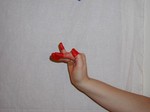Danḍapakṣa
Nṛttahastas - Dance hands (single and combined)
Descriptions and Meanings
9:194
Two Hamsapaksa hands moved alternately and then held out like a staff are called Danḍapakṣa.
9:190
Daṇḍapaksa—the two Haṃsapakṣa hands moved alternately and then held out like a staff.
26:86
When the two hands are stretched, they are called Danḍa-pakṣa.
Not included elsewhere
4:1259-1260
Danḍapakṣa: The hands which are in Haṁsapakṣa Hasta are extended obliquely and moved round (yivartita).
7:92
Dandahasta : If the hands have the formation of hansapaksha and they are spread out obliquely, they are revolved and changed, it is danda hasta.
2:261-262
When the haṁsapakṣa hasta is brought from the side to chest in vyavartana and simultaneously the other hand moves horizontally in line with the shoulder in parivartana, they are danḍapakṣa hastas. This action must be executed by alternating the hands.

Haṁsapaksha - 2:154 No image available
Vyāvartana - 2:209 No image available
Parivartitam - 2:210-211
Not included elsewhere
:890
if the two Hamsapaksas are extended to the two sides, and they are gracefully brought to the top by making them alternately face up and down, it is Dandapaksa hasta
7:120
When the shoulder in haṁsapakṣa moves sideways, it is danḍapakṣa.
3:505-506
One hand in haṁsapaksha is brought from its side near the chest while the other hand in lata is gracefully extended. [The same movement] is done with the hands [lit: body] alternating. This is known as dandapaksa. Some say that both the hands are extended at the same time.

